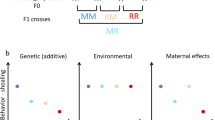Synopsis
Migratory fishes should exhibit higher growth rates and larger body size than nonmigrants. To test this hypothesis, laboratory reared threespine sticklebacks,Gasterosteus aculeatus, representing three populations from a single drainage in northern California, U.S.A. were compared. These populations differ in their migratory patterns, ranging from highly migratory anadromous forms to nonmigratory freshwater residents. The nonmigratory ‘inland’ population was significantly smaller in standard length at most ages, with correspondingly reduced growth rates compared to the more migratory ‘upstream’ and ‘estuary’ populations. Von Bertalanffy growth functions described the growth trajectories of these fish well, accounting for approximately 99% of the variance in body size exhibited by these populations. Broad sense heritability estimates for body size were significant for all three populations at age 60 days but were significant only for the inland population at later ages. The results of this study provide evidence of genetically-based variation in growth rate and body size among these stickleback populations, and these differences are consistent with the hypothesis that adaptation to different migratory lifestyles has occurred.
Similar content being viewed by others
References cited
Allendorf, F., N. Ryman & F. Utter. 1987. Genetics and fishery management: past, present, and future. pp 1–19. In: N. Ryman & F. Utter (ed.) Population Genetics and Fishery Management, University of Washington Press, Seattle.
Alm, G. 1959. The connection between maturity, size, and age in fishes. Rep. Inst. Fresh. Res., Drottningholm 40: 6–145.
Becker, W.A. 1984. Manual of quantitative genetics, fourth revised edition. McNaughton and Gunn, Ann Arbor. 192 pp.
Bell, M.A. 1976. Evolution of phenotypic diversity inGasterosteus aculeatus superspecies on the Pacific Coast of North America. Syst. Zool. 25: 211–227.
Dingle, H. 1980. Ecology and evolution of migration. pp 1–101. In: S.A. Gauthreaux, Jr. (ed.) Animal Migration, Orientation, and Navigation, Academic Press, New York.
Gross, M.T, R.C. Coleman & R. McDowall. 1988. Aquatic productivity and the evolution of diadromous fish migration. Science 239: 1291–1293.
Harden Jones, F.R. 1968. Fish migration. St. Martin's Press, New York. 325 pp.
McKeown, B.A. 1984. Fish migration. Croom Helm, London. 224 pp.
Mousseau, T.A. & D.A. Roff. 1987. Natural selection and the heritability of fitness components. Heredity 59: 181–197.
Northcote, T.G. 1978. Migratory strategies and production in freshwater fishes. pp 326–359. In: S.D. Gerking (ed.) Ecology of Freshwater Fish Production, Wiley, New York.
Roff, D.A. 1984. The evolution of life history parameters in teleosts. Can. J. Fish. Aquat. Sci. 41: 989–1000.
Roff, D.A. 1988. The evolution of migration and some life history parameters in marine fishes. Env. Biol. Fish. 22: 133–146.
SAS Institute Inc.. 1985. SAS user's guide: statistics. SAS Institute Inc., Cary. 956 pp.
Smith, R.J.F. 1985. The control of fish migration. Springer-Verlag, New York. 243 pp.
Snyder, R.J. 1988. Migration and the evolution of life histories of the threespine stickleback (Gasterosteus aculeatus L.) Ph.D. Dissertation, University of California, Davis. 96 pp.
Snyder, R.J. 1990. Clutch size of anadromous and freshwater threespine sticklebacks: a reassessment. Can. J. Zool. 68: 2027–2030.
Snyder, R.J. & H. Dingle. 1989. Adaptive, genetically-based differences in life history between estuary and freshwater threespine sticklebacks (Gasterosteus aculeatus L.). Can. J. Zool. 67: 2448–2454.
Snyder, R.J. & H. Dingle. 1990. Effects of freshwater and marine overwintering environments on life histories of threespine sticklebacks: evidence for adaptive variation between anadromous and resident freshwater populations. Oecologia 84: 386–390.
Sokal, R.R. & F.J. Rohlf. 1981. Biometry, second edition. W.H. Freeman, San Francisco. 859 pp.
Wootton, R.J. 1976. The biology of the sticklebacks. Academic Press, New York. 387 pp.
Author information
Authors and Affiliations
Rights and permissions
About this article
Cite this article
Snyder, R.J. Migration and life histories of the threespine stickleback: evidence for adaptive variation in growth rate between populations. Environ Biol Fish 31, 381–388 (1991). https://doi.org/10.1007/BF00002363
Received:
Accepted:
Issue Date:
DOI: https://doi.org/10.1007/BF00002363




